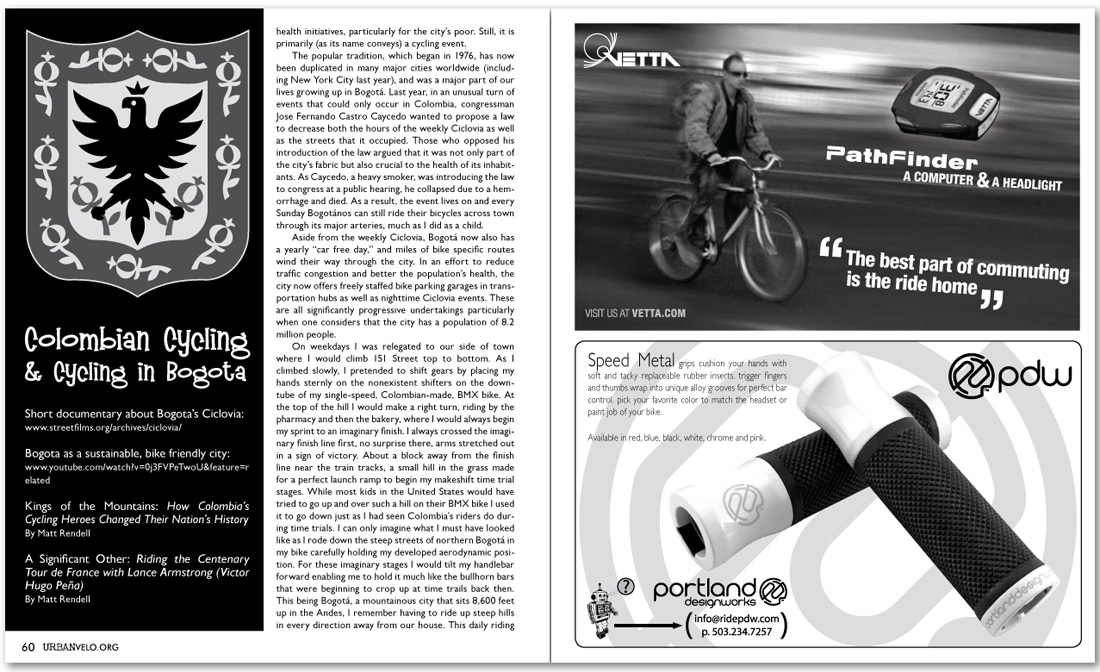| health initiatives, particularly for the city’s poor. Still, it is primarily (as its name conveys) a cycling event.
The popular tradition, which began in 1976, has now been duplicated in many major cities worldwide (including New York City last year), and was a major part of our lives growing up in Bogotá. Last year, in an unusual turn of events that could only occur in Colombia, congressman Jose Fernando Castro Caycedo wanted to propose a law to decrease both the hours of the weekly Ciclovia as well as the streets that it occupied. Those who opposed his introduction of the law argued that it was not only part of the city’s fabric but also crucial to the health of its inhabitants. As Caycedo, a heavy smoker, was introducing the law to congress at a public hearing, he collapsed due to a hemorrhage and died. As a result, the event lives on and every Sunday Bogotános can still ride their bicycles across town through its major arteries, much as I did as a child.
Aside from the weekly Ciclovia, Bogotá now also has a yearly “car free day,” and miles of bike specific routes wind their way through the city. In an effort to reduce traffic congestion and better the population’s health, the city now offers freely staffed bike parking garages in transportation hubs as well as nighttime Ciclovia events. These are all significantly progressive undertakings particularly when one considers that the city has a population of 8.2 million people.
On weekdays I was relegated to our side of town where I would climb 151 Street top to bottom. As I climbed slowly, I pretended to shift gears by placing my hands sternly on the nonexistent shifters on the downtube of my single-speed, Colombian-made, BMX bike. At the top of the hill I would make a right turn, riding by the pharmacy and then the bakery, where I would always begin my sprint to an imaginary finish. I always crossed the imaginary finish line first, no surprise there, arms stretched out in a sign of victory. About a block away from the finish line near the train tracks, a small hill in the grass made for a perfect launch ramp to begin my makeshift time trial stages. While most kids in the United States would have tried to go up and over such a hill on their BMX bike I used it to go down just as I had seen Colombia’s riders do during time trials. I can only imagine what I must have looked like as I rode down the steep streets of northern Bogotá in my bike carefully holding my developed aerodynamic position. For these imaginary stages I would tilt my handlebar forward enabling me to hold it much like the bullhorn bars that were beginning to crop up at time trails back then. This being Bogotá, a mountainous city that sits 8,600 feet up in the Andes, I remember having to ride up steep hills in every direction away from our house. This daily riding
|
|
Colombian Cycling & Cycling in Bogota
Short documentary about Bogota’s Ciclovia:
www.streetfilms.org/archives/ciclovia/
Bogota as a sustainable, bike friendly city:
www.youtube.com/watch?v=0j3FVPeTwoU&feature=related
Kings of the Mountains: How Colombia’s Cycling Heroes Changed Their Nation’s History
By Matt Rendell
A Significant Other: Riding the Centenary Tour de France with Lance Armstrong (Victor Hugo Peña)
By Matt Rendell |

